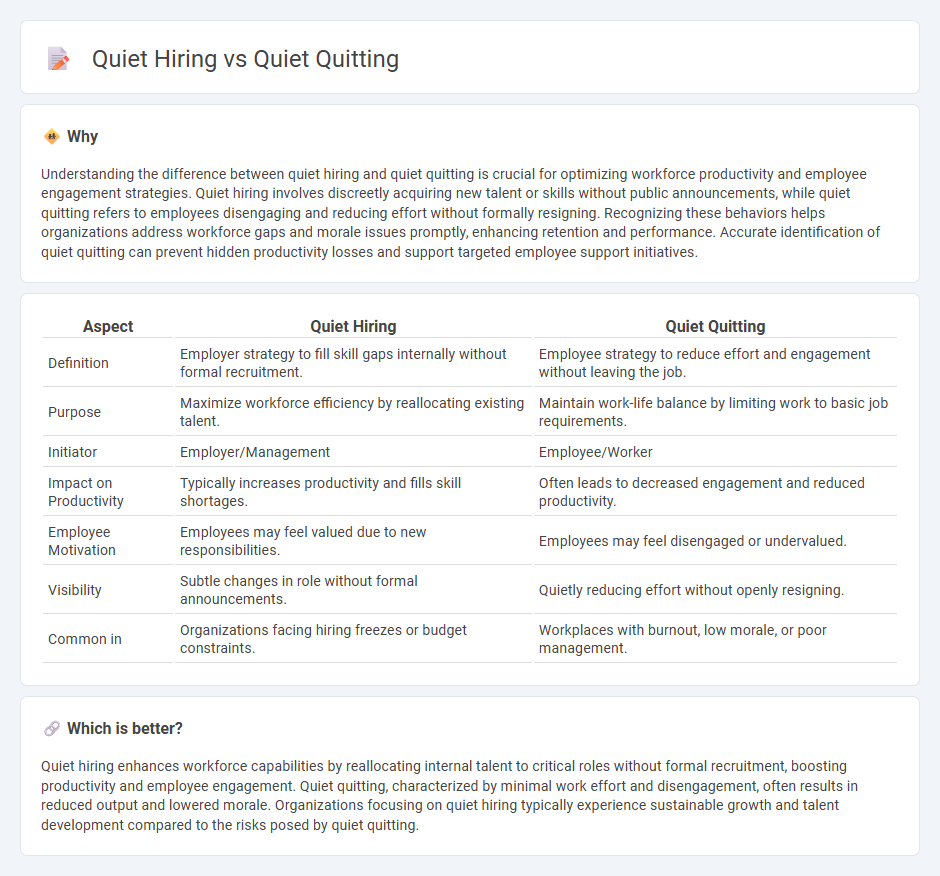
Quiet hiring focuses on maximizing existing employee skills and reallocating internal talent to meet organizational needs without external recruitment. Quiet quitting, by contrast, involves employees doing the minimum required work, often disengaging from additional responsibilities to maintain work-life balance. Discover how these contrasting workforce trends impact productivity and organizational culture.
Why it is important
Understanding the difference between quiet hiring and quiet quitting is crucial for optimizing workforce productivity and employee engagement strategies. Quiet hiring involves discreetly acquiring new talent or skills without public announcements, while quiet quitting refers to employees disengaging and reducing effort without formally resigning. Recognizing these behaviors helps organizations address workforce gaps and morale issues promptly, enhancing retention and performance. Accurate identification of quiet quitting can prevent hidden productivity losses and support targeted employee support initiatives.
Comparison Table
| Aspect | Quiet Hiring | Quiet Quitting |
|---|---|---|
| Definition | Employer strategy to fill skill gaps internally without formal recruitment. | Employee strategy to reduce effort and engagement without leaving the job. |
| Purpose | Maximize workforce efficiency by reallocating existing talent. | Maintain work-life balance by limiting work to basic job requirements. |
| Initiator | Employer/Management | Employee/Worker |
| Impact on Productivity | Typically increases productivity and fills skill shortages. | Often leads to decreased engagement and reduced productivity. |
| Employee Motivation | Employees may feel valued due to new responsibilities. | Employees may feel disengaged or undervalued. |
| Visibility | Subtle changes in role without formal announcements. | Quietly reducing effort without openly resigning. |
| Common in | Organizations facing hiring freezes or budget constraints. | Workplaces with burnout, low morale, or poor management. |
Which is better?
Quiet hiring enhances workforce capabilities by reallocating internal talent to critical roles without formal recruitment, boosting productivity and employee engagement. Quiet quitting, characterized by minimal work effort and disengagement, often results in reduced output and lowered morale. Organizations focusing on quiet hiring typically experience sustainable growth and talent development compared to the risks posed by quiet quitting.
Connection
Quiet hiring involves reallocating existing employees to new tasks without formal recruitment, while quiet quitting reflects employees reducing effort to meet only basic job requirements. Both phenomena signal shifts in workforce engagement and organizational dynamics, impacting productivity and talent management strategies. Companies leveraging quiet hiring must address potential disengagement to prevent the rise of quiet quitting among staff.
Key Terms
Employee Engagement
Quiet quitting reflects employees reduced effort and disengagement, impacting overall productivity and morale within organizations. In contrast, quiet hiring involves companies discreetly elevating workforce capabilities through internal talent development and role adjustments, thereby enhancing employee engagement and retention. Explore strategies to balance these phenomena and boost workplace commitment effectively.
Workforce Optimization
Quiet quitting refers to employees reducing discretionary effort without formally resigning, while quiet hiring involves organizations reallocating existing talent or acquiring skills discreetly to meet business needs. Both strategies impact workforce optimization by balancing costs, productivity, and employee engagement in dynamic market conditions. Explore how leveraging quiet quitting and quiet hiring can enhance your company's talent management and operational efficiency.
Organizational Expectations
Quiet quitting reflects employees doing only their job descriptions without extra effort, signaling a shift in workplace engagement and setting clearer boundaries for organizational expectations. Quiet hiring involves employers distributing tasks or responsibilities among existing staff without formal recruitment, highlighting strategic resource management and talent utilization within organizational frameworks. Explore how both phenomena shape evolving workplace dynamics and influence organizational success.
Source and External Links
What Is Quiet Quitting and Can It Be Prevented? - This article discusses quiet quitting, where employees disengage from their roles by reducing work output and interest in projects, and explores its prevention.
Quiet Quitting: A Proper Guide to a Very Real Trend - This guide explains quiet quitting as a trend where employees fulfill only their minimum job requirements, stopping short of extra efforts, and discusses strategies to address it.
When Quiet Quitting Is Worse Than the Real Thing - This article explores the implications of quiet quitting, where employees opt out of tasks beyond their duties, becoming less invested in their work.
 dowidth.com
dowidth.com